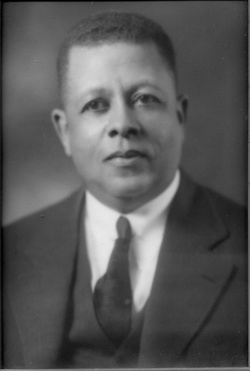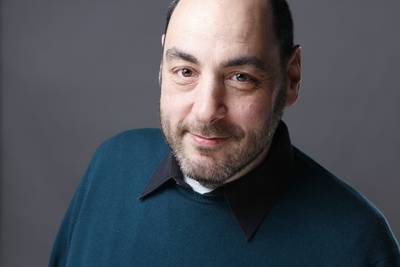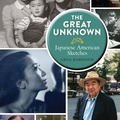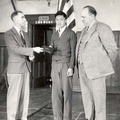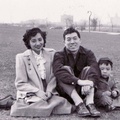Sometimes, the research journey can create unexpected opportunities in the present day.
After the author wrote his Nichi Bei column on the maverick African American attorney Hugh Macbeth regarding his valiant efforts in defense of Japanese Americans during WWII, the author published an extended study on Macbeth in his book titled, After Camp, which was a winner of the Caroline Bancroft History Prize in Western US History. That write-up gained traction, leading to a renewed interest in the African American attorney. Later, Hugh Macbeth was honored during one of the Manzanar pilgrimages.
On top of that, the author had learned during his research that Macbeth had a son, Hugh Jr., who was also an attorney. The author had the opportunity to meet with the son and to share research on his father’s extensive efforts to help Japanese Americans. Until that conversation, the son was unaware of many things—even though he had worked with his father on civil rights cases—and expressed his gratitude toward the author.
Further still, sometimes research can lead to a dead-end until a future, serendipitous event smacks you in the face and brings everything full circle.
While researching Macbeth, the author uncovered some writings of a Nisei journalist and dissident in camp named Conrad Hamanaka. The author was fascinated by Hamanaka but was unable to find an obituary or any postwar writings and was unable to find anybody who knew what became of him.
After time had passed, a friend invited the author to a New Year’s party. There, his friend introduced him to a Japanese American woman named Sheila who wrote a children’s book titled, Be Bop A Doo Walk!, about a Sansei girl and her African American friend in NYC. The author knew the children’s book and that Sheila’s last name was Hamanaka.
The author recounts the chance meeting:
“I thus immediately went over to Sheila and gushed, saying that as a historian of Japanese Americans studying relations with blacks, I had especially appreciated her book. Sheila was flattered by my interest, and explained that it was drawn from her own life. She explained that she had grown up in New York, where her father was a writer and a friend of the Beat poets who then became an actor. Again a light went on in my head, and I said, ‘Did you know by any chance a man named K. Conrad Hamanaka?’ Sheila responded, ‘Yes, that was my Dad, but how did you know his name? He changed it when he went on the stage.’ Thus did I find that the actor Conrad Yama, whom I had seen on the screen and whose career I knew slightly, was none other than Conrad Hamanaka, the man whom I had been seeking. Sheila arranged for me to meet her father, though he was not in shape to really answer my questions.”
(The author shares more research stories in a blog post on the University Press of Colorado website.)
Speaking of research, I wanted to briefly revisit Assistant Secretary of War John McCloy, whom I mentioned briefly above.
There are a couple of articles included in the anthology that address internment revisionists led by certain well-known personalities who drudge up hackneyed arguments of how the Japanese American mass removal was justified and is a positive example of ethnic profiling. Although “[h]istorians have exhaustively documented the primary role of anti-Japanese prejudice and war hysteria by West Coast Army officers and civilians in bringing about the issue of Executive Order 9066” and the revisionists’ evidence is widely regarded as “predominantly old and discredited,” I wanted to briefly discuss a relevant finding by the author in light of certain executive orders that have been issued recently.
The revisionists hold that McCloy was at the center of the decision to round up Issei and Japanese Americans on the West Coast due to national security concerns. The author, however, discovered in his course of researching for his book, By Order of the President, a memorandum dated July 23, 1942, that McCloy sent to Robert Patterson, an employee under the secretary of war.
The content of the memorandum is unimportant. Rather, what I want to point out here is that the author found on it “a handwritten postscript, where McCloy admitted that military security was not a primary factor in triggering the removal of West Coast Japanese Americans: ‘These people are not ‘internees’: They are under no suspicion for the most part and were moved largely because we felt we could not control our own white citizens in California.’”
This admission fatally dooms the revisionists’ argument that national security was the primary reason for the forced removal.
Furthermore, the author writes in the anthology:
“[McCloy] twice went out on a limb during mid-1942 to support Japanese Americans. McCloy and the commanding general of the Hawaiian Department, Delos Emmons, together thwarted Franklin D. Roosevelt’s orders for the mass confinement of Japanese Hawaiians. Meanwhile, McCloy overrode Army opposition to Nisei soldiers and brokered the creation of the famous 442nd Regimental Combat Team. The possibility that these actions represented a concealed form of contrition lends them a special poignancy.”
Apparently the author’s By Order of the President “was published only a few weeks after 9/11, in the climate of uncertainty, and it thus received unusually broad attention for a book of its kind, with reviews in the New York Times, Wall Street Journal, and others of the mainstream press.” So the author most definitely understands how the Japanese American experience during WWII can be compared to modern-day events.
In light of the new administration and some of the executive orders that have been issued, the author comments, “While I am always conscious of the unique nature of the wartime events, and resist easy parallels, I am glad if people can learn from my work about the special importance of protecting fundamental rights in times of crisis.” He goes on to add, “In a time of renewed danger to civil liberties, when the president’s chief counsellor has referred to the press as the opposition party, I hope that people will continue to support their newspapers as a means to speak truth to power.”
So far in this article, I have presumed that the audience is at least familiar with the inexcusable incarceration of West Coast Japanese Americans during WWII, but as the author reflects: “Even today, in spite of the efforts at commemoration and outreach that so many people have made, I find that there are so many Americans who do not know the story of wartime Japanese American incarceration, or have misconceptions.”
To illustrate this reality, the author shares a delightful anecdote from one of his book tours:
“I was assigned a driver to take me to my various engagements. She was born in the postwar era, and had never heard much if anything about Japanese Americans. I spoke with her throughout the day about my research. Just before she was about to drop me at my hotel for the night, I happened to ask where precisely she hailed from. She responded innocently, ‘From a town outside Seattle that you have surely never heard of, called Puyallup.’ As quickly as possible I told her the story of Puyallup and Camp Harmony. She was stunned, and felt almost betrayed that neither her parents nor anyone else in the community had ever mentioned the wartime events there to her.”
At the most basic level, the author through this anthology wants to “help people understand that Japanese Americans are and always have been an extraordinarily diverse population, and that Japanese communities have always included people outside the norm—mixed-race people, gays and lesbians, artists, and the like.” Considering that each piece in this anthology is on average only three to five pages long, readers of this anthology will have trouble putting it down. Setsuko, who is a friend of the author, impeccably described the pieces in this collection as bonbons: easily digestible, sweet, and addictive just like candy! With this treasure trove of individual biographies and unique insights into historical events, he has truly given America a priceless contribution toward broadening the rich Japanese American mosaic.
The author Greg Robinson is a professor of history at Université du Québec à Montréal who has written a number of columns about Japanese Canadians for the Toronto-based newspaper, Nikkei Voice. In addition to the books I have already mentioned in this article, he has also written A Tragedy of Democracy, which was awarded the history book prize of the Association for Asian American Studies.
In Greg’s just-published coedited volume, Minority Relations, he wrote a chapter on the role of African Americans in the Japanese American redress movement. It not only expands on his columns, but also on his presentation at the 2013 JANM conference in Seattle.
He continues to write his regular “The Great Unknown and the Unknown Great” column for Nichi Bei Weekly.
Currently, Greg is engaged in a full-length book project on Eleanor Roosevelt and WWII, and another book project that expands on his work on Japanese Americans in Louisiana. He also continues to work on the history of homosexuality in Nikkei communities.
If anybody has any relevant information that might help Greg in his current endeavors, or who has information on how he can get his books translated into Japanese, please feel free to contact him!
* * * * *
Please join us on Saturday, February 25, 2017, at 2 p.m., as the Japanese American National Museum hosts author and historian Greg Robinson for a book discussion regarding his anthology volume, The Great Unknown: Japanese American Sketches. The program is free with museum admission. Click here for more information and to RSVP. If you are unable to attend, the book is available for purchase in the JANM Store or online.
© 2017 Edward Yoshida


